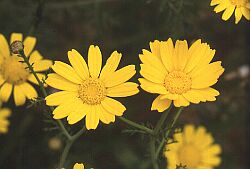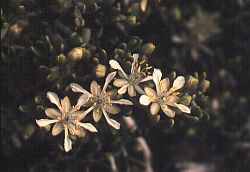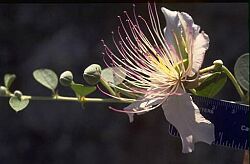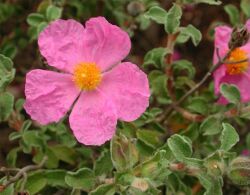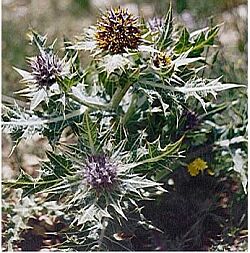The following information was found at: https://www.fisheaters.com/marygardens.html
I do not know anything about the site except they have a great Mary's garden page which I copied here.
Mary Gardens
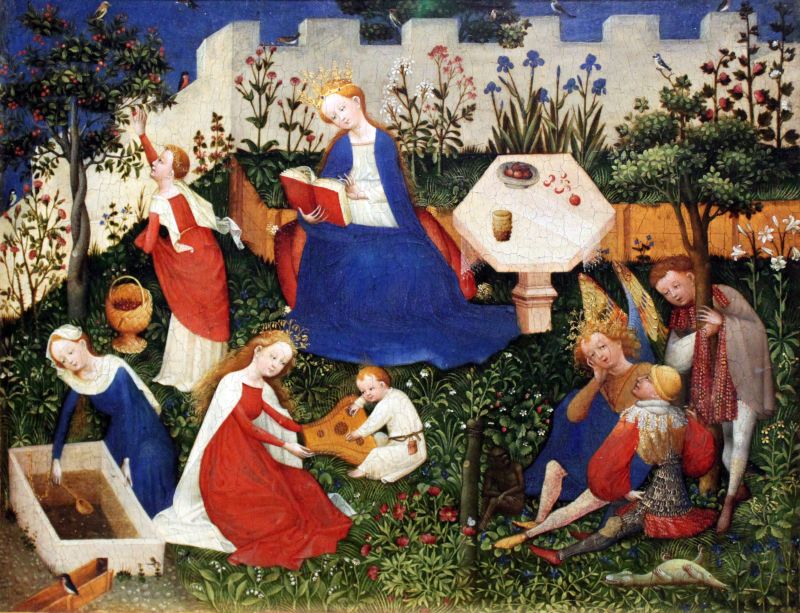
 Mary Garden is a garden, filled with flowers, plants and trees named for Our Lady and Jesus, designed to be a place of beauty that reminds us of our Lord and our Lady, allows one to experience God's creation, and invites prayer and contemplation. Because Mary is a type of the Church as Bride, the garden should be enclosed if at all possible, based on the words in the fourth chapter of Solomon's Canticle of Canticles: Mary Garden is a garden, filled with flowers, plants and trees named for Our Lady and Jesus, designed to be a place of beauty that reminds us of our Lord and our Lady, allows one to experience God's creation, and invites prayer and contemplation. Because Mary is a type of the Church as Bride, the garden should be enclosed if at all possible, based on the words in the fourth chapter of Solomon's Canticle of Canticles:How beautiful art thou, my love, how beautiful art thou! thy eyes are doves' eyes, besides what is hid within. Thy hair is as flocks of goats, which Come up from mount Galaad. Thy teeth as flocks of sheep, that are shorn which come up from the washing, all with twins, and there is none barren among them. Thy lips are as a scarlet lace: and thy speech sweet. Thy cheeks are as a piece of a pomegranate, besides that which lieth hid within. Thy neck, is as the tower of David, which is built with bulwarks: a thousand bucklers hang upon it, all the armour of valiant men. Thy two breasts like two young roes that are twins, which feed among the lilies.St. Benedict had a rose garden ("rosary") at his monastery in the 4th c., but the first garden we know of that was specifically dedicated to Mary was one created by the Irish St. Fiacre in the 7th c. The earliest record of a garden explicitly called a "Mary Garden" involves a "fifteenth century monastic accounting record of the purchase of plants "for S. Mary's garden" by the sacristan of Norwich Priory, in England." 1 Before the rise of Christendom, many flowers were associated with pagan deities -- Diana, Juno, Venus, etc. -- but when the "Age of Faith" ascended and superceded the pagan, these 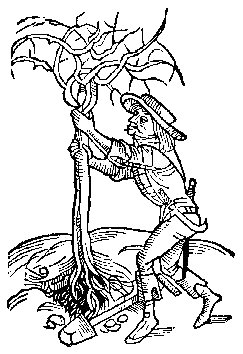 flowers were "christened" and re-dedicated to Christian themes. So many flowers were named for Jesus, Mary, the angels, holy places, etc. -- enough such that you can create a garden focused on specific aspects of Mary and Jesus' lives, such as His Passion or her sorrows. Enchanting names, like "Our Lady's Tears" (spiderwort), "Christ's-Cross Flower" (Summer phlox), "Joseph's Coat" (Amaranthus), "Pentecost Rose" or "Mary's Rose" (peony), and "Our Lady's Mantle" (Morning Glory), abounded. Sadly, during the Protestant rebellion and the rise of secularism, many of these flowers were re-named yet again with more wordly names but, of course, these flowers still exist and to many Catholic gardeners, their religious names are still meaningful. flowers were "christened" and re-dedicated to Christian themes. So many flowers were named for Jesus, Mary, the angels, holy places, etc. -- enough such that you can create a garden focused on specific aspects of Mary and Jesus' lives, such as His Passion or her sorrows. Enchanting names, like "Our Lady's Tears" (spiderwort), "Christ's-Cross Flower" (Summer phlox), "Joseph's Coat" (Amaranthus), "Pentecost Rose" or "Mary's Rose" (peony), and "Our Lady's Mantle" (Morning Glory), abounded. Sadly, during the Protestant rebellion and the rise of secularism, many of these flowers were re-named yet again with more wordly names but, of course, these flowers still exist and to many Catholic gardeners, their religious names are still meaningful.The St. Elizabeth Ann Seton Parish's (in Pennsylvania) Mary Garden Dedication Booklet includes the following, which will give you an idea about how Mary Gardens recall the lives of Mary and Jesus. The booklet asks the reader to visit the garden and think of Mary: "Picture her eyes (Forget-Me-Nots), her hair (Maidenhair Fem), her five fingers (Potentilla). Think about her apparel: her smock (Morning Glory), her veil (Baby's Breath), her nightcap (Canterbury Bells), her gloves (Foxglove), and her shoes (Columbine). Remember her attributes: Mary's humility (Violet), the fruitful virgin (Strawberry), Mary's queenship (Virgin Lily), Mary's Flower of God (English Daisy), Mary's glory (Saint John's Wort), and Our Lady's Faith (Veronica).You can plant flowers whose names and form evoke the Fourteen Stations of the Cross or the Fifteen Mysteries of the Rosary so that by walking through your garden you not only enjoy its natural beauty, but practically "make the Stations" or "walk the Rosary," turning your backyard , schoolyard, or churchyard into a holy shrine (especially when accented with beautiful statuary). If you don't have lots of room, you can make mini-gardens on your patio or apartment's balcony, or grow miniature plants in dishes or terraria for inside your home (nice gifts for the homebound!). If you do have lots of room, especially if you live in the country, consider setting up a little roadside shrine and garden so people passing by can stop and rest at a beautiful sacred place. Below is a table of modern common names, scientific names, and medieval, religious names and meanings of flowers, plants, and shrubs, along with a few other plants relevant to our Lord's life. Separately below in the table, you'll find the same for herbs. The month associated with those flowers deemed as "birth flowers" have the birth months rendered in (italicized parentheses):
This list of flowers and their meanings may help you get started:
Rose – Roses have been associated with Mary since the earliest days. They are a symbol of her glory and sorrow. Roses are often known as the queen of flowers. As such, they are also a sign of Mary’s queenship of heaven.
Lily of the Valley – Mary’s Tears – Legend holds that when Mary wept at the foot of the cross, her tears fell to the ground and these flowers blossomed. With its pure white flowers, it has also been associated with her Immaculate Conception.
Ox-Eye Daisy – Mary’s Star – This flower is associated with the Star of Bethlehem which led the Magi to the Christ child.
Fleur-de-lis – Yellow flag iris – A symbol of the Annunciation, when the angel Gabriel came to Mary to ask her to be the mother of God’s son.
Chrysanthemum – All Saint’s Flower – This flower is believed to have been present when Christ was laid in the tomb.
Snowdrop – Candlemas Bells – These are said to have bloomed at Candlemas, when Mary brought Jesus to the temple for his presentation.
Gladiolus – the name of this flower comes from the Latin word for “sword” and stands for the sword that would pierce Mary’s heart.
Violet – a symbol of Mary’s constancy, humility, and innocence
Marigold – Mary’s Gold – a symbol of Mary’s simplicity and domesticity. Sometimes also associated with her sorrows.
Carnations – their name reminds one of the Incarnation of Christ. They also are a symbol of the Crucifixion.
As you plan your garden, consider planting, depending on where you live, the following to help the liturgical year come alive:
See the page on the Customs of the Liturgical Year
for more information on these practices. ... and when you plant your Mary Garden, let's hope some of "Our Lady's Birds" -- ladybug One more tip: you can make flower pots and cement objects, like statues, look more interesting by inviting moss to grow on them. To do this, mix a quart of buttermilk, a pint of pulverized wood-land moss, a pint of composted manure, and a little Miracle-Grow. Paint onto object with a paintbrush and set the object in a cool, shady place. Keep it moist by spritzing with water or stale beer. Footnotes: 1 Some of the information for this page comes from Mary Gardens website. Their site graciously states, "All texts and graphics of web page and site copyright Mary's Gardens, 1995. All rights reserved. Permission granted to reproduce for promotion of the greater glory of God through knowledge, honor, praise and veneration of, and through devotion and recourse to, the Blessed Virgin Mary." Thank you! 2 Just for fun: "They say" that the nursery rhyme most in the English-speaking world grew up with (see below) comes from medieval farmers burning their fields to clear them for the next sowing season: Ladybird, ladybird, fly away home,3 The evidence of many plant species have been found, either visibly, in pollen form, or both, on the Shroud of Turin. Five of these are below:
|
| MARY GARDENS HISTORICAL PERSPECTIVE |
| John S. Stokes Jr. |
| (Adapted from "An Historical Note" pamphlet written for the Annapolis Mary Garden in 1991).Mary Gardens of the Flowers of Our Lady named for the Blessed Virgin Mary dating back to medieval times bring a wealth of meanings distilled from flower imagery applied to Mary from Scripture by the Church Fathers and early liturgies; and also from "relics" and legends of Our Lady brought back to Europe from Bethlehem, Nazareth and Jerusalem by returning Crusaders and pilgrims; and from many other associations with Mary perceived by the eyes of faith. Cultivated together in contemporary Mary Gardens, the Flowers of Our Lady provide a floral mosaic of Mary's life, mysteries, virtues, excellences and prerogatives which gently lifts our hearts and minds, in love, prayer, praise, thanksgiving and meditation, to the Father, Son and Holy Spirit, and to union with the divine work of creation, salvation and kingdom—"through Mary, through her flowers." The few detailed records of medieval gardens are almost all of monastic vegetable and herb gardens. The name, "Mary Garden" has its recorded origins in medieval religious art and illustration, in which prints, and then paintings, of the Virgin and Child in enclosed gardens of symbolical flowers were entitled "Mary Gardens", and presumably were inspired by actual small gardens of the period. St. Benedict is known to have had a monastic rose garden, or "Rosary", in the 4th Century, but the first reference to an actual garden dedicated to Mary of which we know is from the life of St. Fiacre, Irish patron saint of gardening, who planted and tended a garden around the oratory to Our Lady he built at his famous hospice for the poor and infirm in France in the 7th Century. The association of specific flowers with Mary perhaps begins with the old legend from patristic days that after her Assumption, soul and body, into heaven blooming roses and lilies were found in her tomb. One of the earliest recorded symbolic associations of distinct parts of plants with Mary's attributes was that of St. Bede in the 8th century, who saw the translucent white petals of the lily to be a likeness of her pure body as she was assumed into heaven, and its golden anthers, of the glorious resplendence of her soul. There are old lists of the flowers, herbs and grains included in the "Assumption bundles" of plants which, dating back to the 9th Century, came to be associated with Mary through their blessing at the altar on the Feast of the Assumption—according to the liturgy preserved in the Roman Rite—and then reserved at home or workplace as religious objects, as we reserve palms blest on Palm Sunday today. St. Bernard's words in praise of Mary in the 12th century as "The rose of charity, the lily of chastity, the violet of humility. . . and the golden gillyflower of heaven" are illustrative of the medieval discernment of particular flowers as representing specific virtues and excellences of Mary. The first record we have found of a flower actually named for Mary is that of "seint mary gouldes" (St. Mary's Gold or Marygold) for the Pot Marigold or Calendula, in a 1373 English recipe for a potion to ward off the plague. The first reference in a horticultural work is to "Our Lady's Slipper" in the herbal of Vitus Auslasser published in Germany in 1479. The first mention known to us of an actual Mary Garden by name is in a 15th Century monastic accounting record of the purchase of plants "for S. Mary's garden" by the sacristan of Norwich Priory, in England. Some flowers, such as the Madonna Lily—which is still found growing wild in remote places in the Holy Land—are commonly known today by religious names clearly reflecting their association with Mary. Others including the Marigold, Ladies' Mantle, and Ladyslipper are held to be named for Mary according to authorities such as the Oxford English Dictionary, which states that the names, "Lady," "Lady's," and "Ladies," in the older English plant names are almost always fore-shortenings of "Our Lady". Similarly, "Virgin," and "Mary's" are considered in most cases as referring to the Virgin Mary, with parallels in other European languages. Frequently namings of "Mary's" and "Our Lady's" will be found in different localities for the same plant. Hundreds of such associations are still found extant in living oral religious traditions of the country-sides. Interestingly, these have mostly been recorded not in religious annals but by botanists, in the "floras" of the various countries, that future botanists may find them in their natural locations through inquiry by names known to local residents. In some instances plants were given scientific, botanical, names derived from their prior popular religious names, as with the Milk Thistle, or Silybum Marianum, named from the widespread imaginative legend that the white spots on its leaves (and those of other plants) originated when drops of the Nursing Madonna's milk fell on them. Other plants, such as those collected from Asia by botanists, horticulturists and travelers, were given Mary names after being brought back to Europe for cultivation. An example is that of the Assumption Lily, native to China and Japan, and named in Europe for its bloom at Assumptiontide in mid-August. Contemporary Mary Gardens assemble together suitable flowers so named for Mary from various countries in a single garden where they can be used together devotionally according to their old names and symbolism. The present-day Mary Garden movement has its origins in the Garden of Our Lady planted in 1932 around a figure of Our Lady of the Annunciation beside the angelus tower of St. Joseph's Church in Woods Hole, on Cape Cod, Massachusetts by Frances Crane Lillie, a summer resident of Woods Hole and a benefactor of St. Joseph's. This garden, maintained by a trust fund, was restored to its original planting plan for its golden jubilee in 1982. The notable Annapolis Mary Garden—initially laid out through the expertise of horticulturist Tony Dove, who at that time was Curator of the London Tower Public Gardens in Edgewater, Maryland—was dedicated in a special blessing ceremony on the Vigil of the Assumption, 1988, in honor of the Blessed Virgin Mary and her Divine Son, and as a tribute to the deep faith in Mary of John Carroll, first Bishop of the United States, and to his constant recourse to Mary for the protection and blessing of his undertakings for the development of the early United States Church. The pink Vermont granite focal statue of Mary and the boy Jesus, "Mary of Nazareth"—especially designed for the Annapolis Mary Garden by renowned sculptor, Leo Irrera, in residence at the Pius VI Religious Art Center in Washington, D.C. and designer and coordinator of the Navy Memorial in D.C.—was installed in 1991, with blessing on the feast of the Birth of Mary. The Flowers of Our Lady include many flowers uniquely native to the Americas which were adopted and named as symbols of their faith by early Christian explorers, missionaries, converts and settlers. Notable among these are three which have become known and cultivated throughout the world: the Marigold (recalling the European Marigold), Passion Flower and Fuchsia (Our Lady's Eardrops). Other widely cultivated American plants commonly known by religious names locally or regionally—as recorded, like those of Europe, by botanists, folklorist and lexicographers—include the Poinsettea ("Christmas Flower"), Zinnea ("Little Mary"), Blue Morning Glory ("Our Lady's Mantle"), Ageratum ( "St. John's Flower"), Celosia ("Jesus Plant"), Cosmos ("St. Michael"), Caladium ( "Heart of Jesus"), Calceolaria ("Our Lady's Slipper"), Gloxinia ("Canterbury Bells"), Tiger Flower, ("Christ's Knee"), Dahlia, ("Church Flower"), Sunflower, ("Marigold of Peru") and Yucca ("Tower of Ivory"). Also included among the Flowers of Our Lady are numerous centuries-old flower symbols of the Nazareth household articles: of Mary's needlework, lace, pincushion, mirror, brushes, comb, duster, drying plant, ladle, candle, knives and forks, etc. Also of Mary's features: her eyes, hair, hand, fingers; of her garments: her mantle, smock, veil, shawl, slippers; and of her food: bread, cheeses, flavoring. Reflection on these symbols brings us to meditation on the daily life of the Holy Family, in Nazareth, as Mary and Joseph nurtured the boy Jesus in his growth "in age, wisdom and grace before God and man". The flower symbols of Mary's spiritual life and mysteries include: the white "Madonna Lily" of her immaculate purity, "Mary's Rose" of spiritual love, the pansy of "Our Lady's Delight" in the Trinity, first revealed to Mary, the "Lily-of-the-Valley" of her humility, the violet of "Our Lady's Modesty", "Mary's Tulip" of spiritual openness, the strawberry—"Fruitful Virgin"—of her virginal motherhood (in flower and fruit at the same time), "Our Lady's Bedstraw" of the manger, "Christmas Rose", "Star of Bethlehem", several "Mary's Milkdrops" plants, and the "Mother Love" Impatiens, named from its constancy of bloom. Also, "Lent Lily", "Penitant's Rose", "Passion Flower", "Crown of Thorns", "Christ's Back", "Christ's Knee", "Christ's Blood Drops", "Tree of the Cross", the tiny pendant flowers of numerous "Our Lady's Tears" plants for Mary's weeping at the foot of the Cross, "Mary's Sword of sorrow." And, "Pentacost Rose" of the descending flames of the Holy Spirit, white "Assumption Lily", "Mary's Gold" of her heavenly glory and the glory of her appearances on earth, "Mary's Crown", "Christ's Eye", "Sweet Mary" of her heavenly sweetness, the wild orchid of "Mary's Hand of Pity", "Mary's Balm" and other fragrant healing herbs of her spiritual comfort, "Our Lady's Keys" of her mediational access to the storehouses of heavenly grace, "Ladder to Heaven", "Heavenly Way", and so many others. Since many graces and spiritual illuminations have been received through the years as hearts have been raised to prayer while beholding the symbolical Flowers of Our Lady, and since Mary is immediately present by her action as Mediatrix of All Grace, wherever grace is distributed, the gift of a sense of her presence has been experienced by many in garden and countryside. As a consequence many flowers resembling the human form have come to be named as symbols of Mary's presence: "Mary", "The Virgin", "Mary's Face", "Our Lady by-the-Gate", "Our Lady in the Corn", "Our Lady of the Meadow", "Our Lady of the Lake", "Beautiful Lady"; along with indirect symbols of her presence such as the leaves of "Our Lady's Thumb" (prints), "Our Lady's Bite" (marks), etc. Liturgically blest through a ritual of the Roman Rite, Mary Garden focal statues and their surrounding Flowers of Our Lady become holy objects which are vehicles, especially to those so disposed, of actual graces from the merits of Christ and the Church opening minds and elevating thoughts in religious reflection. Inspired by a 1946 article in Perpetual Help magazine by Rev. James J. Galvin, C.SS.R. about the St. Joseph's Mary Garden in Woods Hole, the late Edward A. G. McTague and the writer founded Mary's Gardens of Philadelphia in 1951 as a spare-time, avocational, religious project which undertook world-wide research into the Flowers of Our Lady; made available seeds and plant source information for starting Mary Gardens; and initiated a series of inspirational articles in religious publications. From 1968 through 1982 the work was carried forward by a third co-worker, the late Bonnie Roberson of Hagerman, Idaho—who initiated the research into the Latin American Flowers of Our Lady; developed indoor dish Mary Gardens and Mary Gardens for the blind; and undertook extensive personal correspondence with those inquiring both nationally and from Europe and Japan. In 1973 we were joined by Brother Sean MacNamara, of the Christian Brothers in Dublin, Director and past President of the Irish Garden Society, who became our Irish associate; conducted extensive research into the traditional Irish Flowers of Our Lady, including those named "Mhuire" for Mary in Gaelic; wrote numerous articles; and assisted many in starting outdoor and dish Mary Gardens. Since 1982 a primary source for Mary Gardens information has been Jane A. McLaughlin, parish historian and head of the Mary Garden Society of St. Joseph's Church, who, with Brother Sean, provided information for the starting of the National Irish Mary Garden at Our Lady's Shrine at Knock in County Mayo, by Monsignor James Horan, late Shrine Director, and also assistance for the planting of the Annapolis Mary Garden. Over 30,000 inquiries about the Flowers of Our Lady and Mary Gardens have been answered. Among horticulturists a special initiative in spreading the practice of starting Mary Gardens was undertaken by Daniel J. Foley, Editor of Horticulture magazine, whose definitive article, "Mary Gardens", was published in the 1953 issue of The Herbarist, of the Herb Society of America. It was a member of the Herb Society who introduced Mary-Gardening to St. Mary's parishioner, Nanette Sears, prime-mover of the Annapolis Mary Garden, who planted her own first small Mary Garden at her home in 1957. Other Mary Gardens of special note through the years include a series of gardens planted at the Notre Dame high schools of Mindanao, in the Philippines, in a competition for the Bishop Mongeau 1953 Marian Year trophy; and several with which we were not directly involved: a monastery planting of Mary Flowers in the Holy Land of which we have learned from our correspondents; the collection of Flowers of the Virgin at Lincoln Cathedral in England; and the four acre Mary Garden at the Akita Shrine of Our Lady in Japan, established by Bishop John P. Ito of Akita. Like the Annapolis Mary Garden, each of these gardens gives special emphasis to native plant materials of Our Lady: the flowers of the Holy Land; the "Mhuire" flowers of Ireland; the flowers of the English countryside at Lincoln; and sculptured tree and shrub landscape tableaux of Gospel scenes at Akita. John S. Stokes Jr. Co-Founder, Mary's Gardens U.S.A. Copyright 1991, 1995 This article was taken from Mary's Gardens Home Page on the World Wide Web. (http://www.mgardens.org) Mary's Gardens was founded in 1951 in Philadelphia, Pennsylvania to research the hundreds of flowers named in medieval times as symbols of the life, mysteries and privileges of the Blessed Virgin Mary, Mother of Jesus—as recorded by botanists, folklorists and lexicographers; and to assist in the planting of "Mary Gardens" of "Flowers of Our Lady" today. Communications and requests for further information may be addressed to: marysgardens@mgardens.org All texts and graphics of web page and site copyright Mary's Gardens, 1995. All rights reserved. Permission granted to reproduce for promotion of the greater glory of God through knowledge, honor, praise and veneration of, and through devotion and recourse to, the Blessed Virgin Mary. |
Provided Courtesy of:
Eternal Word Television Network 5817 Old Leeds Road Irondale, AL 35210 www.ewtn.com |
